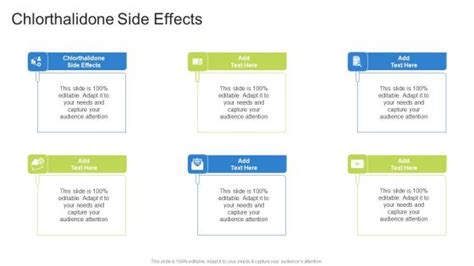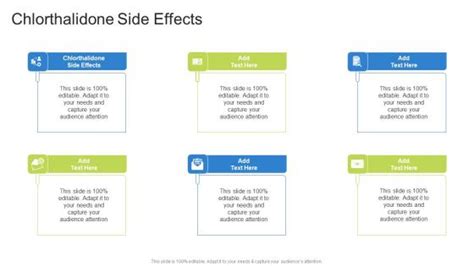The importance of understanding the potential side effects of medications cannot be overstated. Chlorthalidone, a diuretic used to treat high blood pressure and edema, is no exception. While it can be an effective treatment for these conditions, it's crucial for patients to be aware of the possible side effects they may experience. This knowledge enables them to make informed decisions about their health and to recognize when they should seek medical attention. In this article, we will delve into the world of chlorthalidone, exploring its uses, benefits, and, most importantly, its side effects.
Chlorthalidone belongs to a class of drugs known as thiazide-like diuretics. It works by helping the kidneys remove more waste and excess fluids from the body, which in turn lowers blood pressure and reduces swelling. This mechanism of action is beneficial for patients with hypertension and fluid retention. However, like all medications, chlorthalidone is not without its drawbacks. The side effects can range from mild and temporary to severe and potentially life-threatening. It's essential for patients to understand these risks to ensure they can manage their treatment effectively.
Understanding the side effects of chlorthalidone is also vital for healthcare providers. By being aware of the potential adverse reactions, doctors can monitor their patients more closely and adjust treatment plans as necessary. This proactive approach can help minimize the risk of complications and improve patient outcomes. Furthermore, recognizing the side effects of chlorthalidone can facilitate better communication between healthcare providers and their patients, leading to more personalized and effective care.
Introduction to Chlorthalidone Side Effects
Chlorthalidone side effects can be categorized into common, less common, and rare. Common side effects are those that affect a significant number of patients and are often mild and temporary. These can include increased urination, dizziness, and headache. Less common side effects are more severe and may require medical attention. They can include dehydration, electrolyte imbalance, and allergic reactions. Rare side effects are the most severe and can be life-threatening. These can include severe allergic reactions, kidney damage, and increased risk of osteoporosis.
Common Chlorthalidone Side Effects
The common side effects of chlorthalidone are typically not serious and may subside as the body adjusts to the medication. However, it's essential to monitor these effects and report any concerns to a healthcare provider. Some of the common side effects include:
- Increased urination: This is one of the most common side effects of chlorthalidone due to its diuretic action.
- Dizziness: Patients may feel dizzy or lightheaded, especially when standing up from a sitting or lying down position.
- Headache: Mild to moderate headaches can occur due to dehydration or changes in blood pressure.
- Fatigue: Feeling tired or weak is a common complaint among patients taking chlorthalidone.
- Nausea and vomiting: Some patients may experience nausea or vomiting, which can lead to dehydration if not managed properly.
Less Common Chlorthalidone Side Effects
Less common side effects of chlorthalidone can be more severe and may require medical intervention. These include:
- Dehydration: Excessive loss of fluids can lead to dehydration, characterized by symptoms such as dry mouth, dark urine, and decreased urine output.
- Electrolyte imbalance: Chlorthalidone can cause an imbalance of essential minerals like potassium, sodium, and chloride, leading to muscle weakness, heart arrhythmias, and other complications.
- Allergic reactions: Some patients may be allergic to chlorthalidone, which can manifest as skin rash, itching, swelling, or difficulty breathing.
Rare but Serious Chlorthalidone Side Effects
Rare side effects of chlorthalidone are the most severe and can be life-threatening. These include:
- Severe allergic reactions: Anaphylaxis is a rare but potentially fatal allergic reaction that requires immediate medical attention.
- Kidney damage: Long-term use of chlorthalidone can affect kidney function, especially in patients with pre-existing kidney disease.
- Increased risk of osteoporosis: Chlorthalidone can increase the excretion of calcium in the urine, potentially leading to osteoporosis over time.
Managing Chlorthalidone Side Effects
Managing the side effects of chlorthalidone involves a combination of lifestyle adjustments and medical interventions. Patients can reduce the risk of side effects by:
- Staying hydrated: Drinking plenty of water can help prevent dehydration.
- Monitoring urine output: Patients should report any significant changes in urine output to their healthcare provider.
- Following a balanced diet: Eating a diet rich in essential minerals can help prevent electrolyte imbalances.
- Regular health check-ups: Regular monitoring of blood pressure, kidney function, and electrolyte levels can help identify any potential issues early.
Conclusion and Future Directions
In conclusion, while chlorthalidone is an effective medication for treating high blood pressure and edema, it's crucial for patients to be aware of the potential side effects. By understanding these risks and taking proactive steps to manage them, patients can minimize the likelihood of complications and maximize the benefits of their treatment. As research continues to uncover more about the effects of chlorthalidone, healthcare providers and patients must work together to ensure that this medication is used safely and effectively.
Final Thoughts and Recommendations
As we move forward in the management of hypertension and edema with chlorthalidone, it's essential to prioritize patient education and empowerment. By providing patients with comprehensive information about the potential side effects of chlorthalidone and involving them in the decision-making process, we can improve treatment adherence and outcomes. Furthermore, ongoing research into the long-term effects of chlorthalidone and the development of new, safer alternatives will be critical in advancing the field of cardiovascular medicine.
Encouraging Patient Engagement
We encourage all patients taking chlorthalidone to engage actively with their healthcare providers. This includes asking questions about potential side effects, reporting any changes in their condition, and seeking advice on how to manage these effects. By fostering a collaborative relationship between patients and healthcare providers, we can ensure that chlorthalidone is used in a way that maximizes its benefits while minimizing its risks.
What are the most common side effects of chlorthalidone?
+
The most common side effects of chlorthalidone include increased urination, dizziness, headache, fatigue, and nausea.
Can chlorthalidone cause dehydration?
+
Yes, chlorthalidone can cause dehydration due to its diuretic effect. Patients should drink plenty of water to prevent dehydration.
How can I manage the side effects of chlorthalidone?
+
Patient can manage the side effects of chlorthalidone by staying hydrated, monitoring urine output, following a balanced diet, and attending regular health check-ups.
We invite readers to share their experiences with chlorthalidone, ask questions, and engage in discussions about the management of its side effects. Your input is invaluable in creating a supportive community that prioritizes patient-centered care and promotes the safe and effective use of medications like chlorthalidone.








